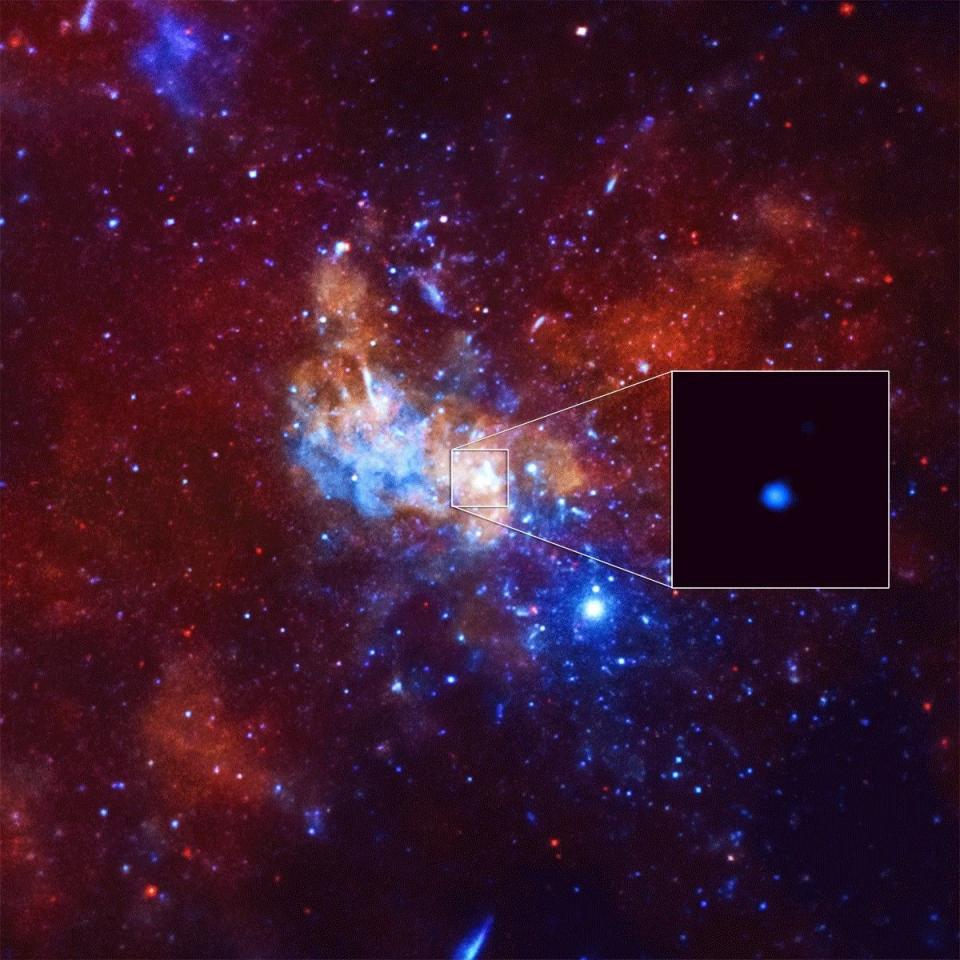Three Scientists Shaped How We Think About Black Holes. Now They Have a Nobel Prize.
The Royal Swedish Academy of Sciences awarded the Nobel Prize in Physics 2020 to three scientists for their groundbreaking work on black holes.
Mathematician Roger Penrose will split the prize with the astrophysicists Reinhard Genzel and Andrea Ghez.
Penrose solidified the mathematical understanding of black holes—proving Einstein was, in fact, correct—while Genzel and Ghez are credited with discovering Sagittarius A*, the black hole at the center of the Milky Way.
A trio of scientists received the call of a lifetime this morning. The Royal Swedish Academy of Sciences awarded the 2020 Nobel Prize in Physics to three researchers for their work unraveling the mystery and majesty of one of the universe's strangest phenomena.
"This year's prize celebrates the discovery of one of the most exotic objects in our universe: the black hole," David Haviland, the chair of the Nobel Committee for Physics, said during a press conference in Stockholm, Sweden.
🌌 You love our badass universe. So do we. Let's explore it together.
Black holes are impossibly massive cosmic objects whose gravitational pull is so strong, not even light can escape their grip. Stars that orbit too close are drawn into a black hole, which is surrounded by a glittering expanse called the event horizon.
Our understanding of these mysterious objects has sharpened in recent decades; the first image of a black hole was taken in April 2019, for example. (The Event Horizon Telescope astronomy network, which snapped the pictures, is also on the short list for a Nobel prize.)
Roger Penrose, a professor of astrophysics at the University of Oxford, will share the $1.1 million prize with astrophysicist Reinhard Genzel of UC Berkeley and Germany's Max Planck Institute for Extraterrestrial Physics, and astrophysicist Andrea Ghez of UCLA, who will split one half of the award.
Just 10 years after Albert Einstein's death, Penrose proved the formation of black holes was, in fact, mathematically possible. Penrose's equations revealed not only that black holes exist, but that Einstein's theory of general relativity paved the way for these mysterious cosmic phenomena to exist. His work led to a breakthrough in the understanding of black holes and their inner workings, including the concept of singularity, the point within a black hole at which time and space cease to exist.
Ghez and Genzel are credited with discovering Sagittarius A*, the supermassive black hole at the center of our galaxy. Separately, they discovered a pattern of motion in stars near the center of the Milky Way, which suggested the presence of a mysterious supermassive object. Over the course of several decades, their observations all but confirmed the presence of a black hole at our galaxy's center.
📥 Make your inbox more awesome.
Laying the Mathematical Groundwork
After Albert Einstein unveiled his General Theory of Relativity in 1915, scientists began puzzling over the concept of black holes. A large number of physicists (including Einstein himself) weren't convinced that the mysterious phenomenon could be reconciled with general relativity.)
The German astronomer Karl Schwartzschild theorized in the following months that if there were enough matter and energy packed into a small enough area, it might collapse and lead to singularity, "a point in spacetime at which the predicted gravitational strength is calculated to be infinite," theoretical physicist James Unwin, of the University of Illinois at Chicago, tells Popular Mechanics.
The discovery of quasars and their ultra-bright radio waves in 1963 revived interest in the search for black holes.

It wasn't until a decade after Einstein's death that the cosmic puzzle pieces began to fit together. In 1965, a breakthrough came to Penrose, then a professor of mathematics at Birkbeck College at the University of London, while he was on a walk with a colleague. Later that day, the Royal Swedish Academy of Sciences explains, he brought this idea to the drawing board and realized its potential.
In his landmark 1965 paper, “Gravitational Collapse and Space-Time Singularities,” published in the journal Physical Review Letters, Penrose proposed, in part, that black holes are a type of "trapped surface" in which rays of, say, light can only travel in one direction regardless of the direction in which the surface is bent.
“He introduced new mathematical tools and proved with mathematical rigor that the formation of black holes is an inevitable consequence of general relativity,” Ulf Danielsson, a theoretical physicist at Uppsala University in Sweden, said during this morning’s press conference.
“What Penrose showed is that the spacetime—this four-dimensional description of the universe—around the black hole goes through a very particular switch when you cross a distance to the black hole called the event horizon,” astrophysicist Feryal Özel of the University of Arizona, tells Popular Mechanics.
Penrose concluded that the time coordinate (in which we measure our past, present and future) switches to become the space coordinate once you pass through the event horizon. “Your future becomes the direction toward the black hole,” Özel explains. “It becomes inevitable to go there.” This, ultimately, leads to singularity.
"Penrose then continued to advance our understanding of black holes in his work with Stephen Hawking, resulting in the Penrose-Hawking singularity theorems," says Unwin. (Ultimately, Hawking, who died in 2018, was never awarded a Nobel Prize for his cosmological work.)
In his spare time, Unwin also notes, Penrose also devised a mathematical structure that underlies quasi-crystal materials. One of his close colleagues received the 2011 Nobel Prize in Chemistry for this effort.
Black holes are now a standard fixture in our understanding of cosmology. Astrophysicists have since puzzled out four main classifications of black hole: miniature black holes, stellar mass black holes, intermediate mass black holes, and supermassive black holes. They’re found throughout the universe, including in our own cosmic backyard.
A Mystery at the Milky Way’s Center

In 1931, an astronomer named Karl Jansky caught wind of a strange radio signal emanating roughly 26,000 light-years from Earth, near the center of our galaxy. The signal, eventually dubbed Sagittarius A*, plagued scientists, who, for years, could not pinpoint its origin. Then, in 1971, two astronomers, Martin Rees and Donald Lynden-Bell, proposed that a supermassive black hole might be the culprit. It was off to the celestial races.
Separate teams led by Genzel and Ghez have spent several decades toiling away, searching for concrete evidence that the object at the center of our galaxy was, in fact, a supermassive black hole. But it hasn't been an easy task.
The center of the Milky Way is shrouded in a dense cloud of gas and dust nearly impenetrable to optical telescopes. In order to cut through the noise, so to speak, astronomers must use infrared telescopes to peer into the heart of our galaxy. Genzel and his team turned to the Very Large Telescope array in Chile’s Atacama desert to make their observations. Ghez and her team, meanwhile, tapped the Keck Observatory atop Hawaii’s Mauna Kea volcano to conduct theirs.
Our Very Own Black Hole
Using these infrared telescopes, Genzel and Ghez tracked the movement of stars and stellar clouds dust in the vicinity of this peculiar cosmic mystery spot. They discovered that as stars in orbit around this curious location approached it, they sped up and their infrared signatures mysteriously brightened.
“When there is a bright source that is not explainable by luminous matter—like a collection of stars—we turn to the pull of gravity as an explanation for this,” Özel says. If nearby stars or the dust clouds they produce get too close to the black hole, they begin to circle it like water flushed down a toilet bowl in a phenomenon called the accretion process.
“Because they’re falling into this deep gravitational potential, they actually heat up to millions or even billions of degrees,”Özel explains. “When matter reaches that temperature before it crosses the event horizon and becomes part of the black hole, it radiates copiously.”
Genzel and Ghez’s teams tracked one star in particular: a young, blue star called S0-2, which orbits Sagittarius A* once every 16 years. At its closest approach, So-2 swings within 17 light-hours (11 million miles) away from the invisible object and can reach speeds of up to 5,000 miles per second, according to the New York Times.
Together, their calculations have provided the strongest evidence yet that a supermassive black hole lies at the heart of our galaxy. This black hole has a mass roughly four times that of our sun packed within a space approximately the size of our solar system. (Don't worry, it poses virtually no threat to Earthlings.)
Exploring our own galaxy in greater detail strengthens our understanding of the cosmos. "We have learned about the structure of our galaxy and similar galaxies like it, we can use this knowledge to advance our understanding about how galaxies form," Unwin explains.
Physics' Brightest Stars
Penrose's theoretical breakthrough paved the way for astrophysicists like Genzel and Ghez.“It is all kind of intertwined,” Özel says. "Science works that way. We build on each other's work and observations and theories.”
Thanks to this award, Ghez will now join an illustrious crew of scientists. She is one of just four women to be awarded the Nobel Prize in Physics. Marie Curie was the first in 1903 followed by Maria Goeppert Mayer 60 years later and Donna Strickland in 2018.
“I hope I can inspire other young women into the field,” she said at the press conference. “It’s a field that has so many pleasures, and if you are passionate about the science, there’s so much that can be done.”
🔭 The Best Telescopes for Stargazing
You Might Also Like
